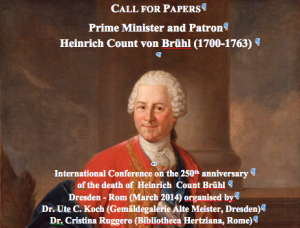 After attaining the Polish Crown, the Wettin Elector pursued the expansion of Dresden in order to transform it into a prestigious residence. Dresden evolved in the 18th Century as a cultural centre of the Reich with outstanding art collections and a particular concentration of artists, architects, composers and singers.
After attaining the Polish Crown, the Wettin Elector pursued the expansion of Dresden in order to transform it into a prestigious residence. Dresden evolved in the 18th Century as a cultural centre of the Reich with outstanding art collections and a particular concentration of artists, architects, composers and singers.
The Saxon Prime Minister Heinrich Count von Brühl (1700-1763) was a key figure in this development: he has been responsible for the art collections, including the purchase of works of art, as well as the Court Theatre, the Court Opera and of the Meissen porcelain factory. He was also a close advisor of the Elector and King – and thus as “the second man in the state” – responsible for all domestic, foreign and financial matters at the Dresden court. Using the nearly unrestricted freedom of choice associated with this position for his own gain, he also built up a considerable personal fortune, which was made up of capital, farms, factories, works of art and luxury goods.
The lavish household of Count von Brühl is exemplified by the Comital Palais and the corresponding Garden ensemble designed by Johann Christoph Knöffel. Included within the palace complex was a library, a gallery, a theatre, gardens and entertainment areas. This extraordinary complex of buildings on the banks of the Elbe, the so-called “Brühl’s Terrace”, was severely damaged in the Seven Years War (1756-1763) – the Saxons economically and financially collapsed into bankruptcy – by the troops of King Frederick II of Prussia in the form of a damnatio memoriae. Moreover, in the 19th century, several buildings including gallery and Bruhl Palace were torn down, thus only city views by Bellotto and a series of engravings made by Michael Keys give us an impression of the original ensemble.
The 250th anniversary of the death of Heinrich Count von Brühl will be taken as an opportunity to assess the field of research on this controversial valued patron and collector, and to identify further areas of investigation. A central point of inquiry of this conference is Brühl’s patronage: Brühl built up not only numerous collections, but was also an important patron for domestic and foreign painters, sculptors and architects. Brühl used a network of specialized art agents and artists for internationally competitive extension and development of its own and the court collections. The aim of this conference will be to carry out a comparative and synthetic analysis of both unpublished sources and material that has not yet been systematically considered.
The conference will take place depending on the number of contributions on two dates in Dresden and Rome in March 2014. The Bibliotheca Hertziana and the Dresden State Art Collections are the organizers.
We seek submissions from art and architectural historians, but also from scholars of related disciplines. Suggested topics may include
– Reconsiderations of the negative assessment of the person and work of the Prime Minister;
– The works of art and architectures created for Brühl and the artists working for him;
– The networks and their protagonists, though which Brühl acquired his extensive collections (eg Carl Henry Heineken, Joseph Anton von Wackerbarth, Francesco Algarotti, Pietro Maria Guarienti, Lorenzo and Rossi Bonaventure, and others);
– Comparison of the arts policy of Brühl and of his Elector Augustus III: the different design of the collections, the construction activities or the propaganda using the printmaking;
– Structures and persons of the Saxon court;
– Other Saxon collectors (eg, Count von Manteuffel. of Hoym, Flemming, Sulkowski);
– The role of Brühl as a private and institutional patron in the European/international context and the comparison with other prime ministers;
– Planned sections: Brühl as a politician and collector / Artists in the service of the Count / Networks / Brühl and Augustus III. / International Contexts.
Please send your proposal as an abstract (approx. 300 words) for a 20-minute paper in German, English or Italian together with a brief curriculum vitae and any reading list until 15th October 2013 (deadline):

Leave a Reply
You must be logged in to post a comment.